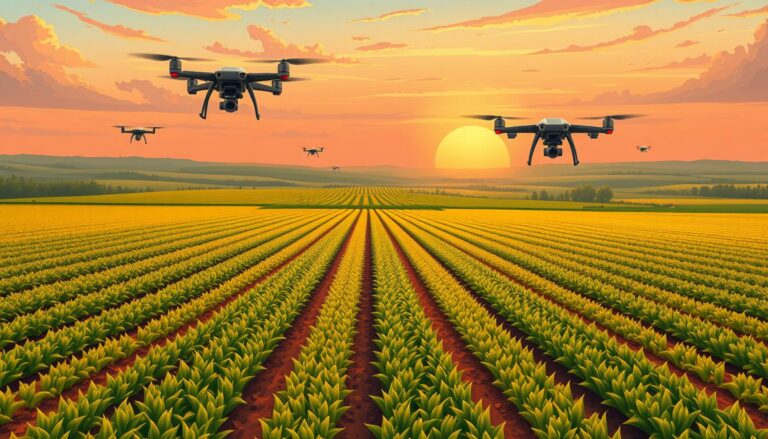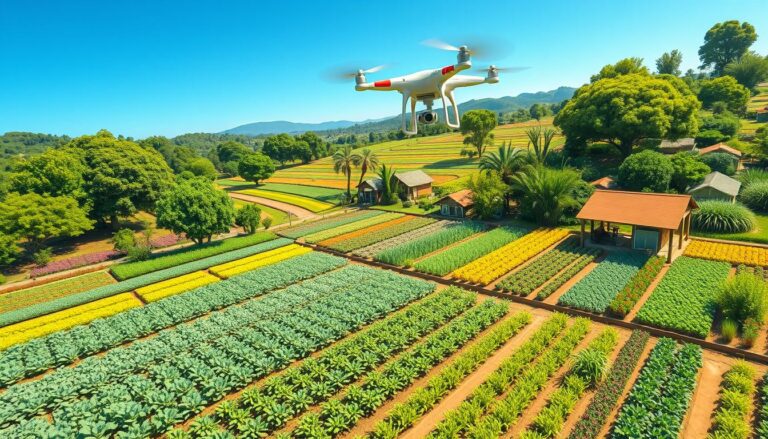Regenerative Agriculture Basics
Regenerative agriculture is a way to farm that makes the soil healthy, boosts biodiversity, and fights climate change. It looks at farming as a whole, aiming to help both people and the planet. This method uses agroecology to build strong ties between farmers, communities, and nature.
Old farming ways have harmed the soil with too much tilling, chemicals, and growing just one crop. This has caused land erosion to go up by 10 to 100 times more than soil can form. Regenerative farming works to fix this by improving soil health with no-till, cover crops, and rotating crops.
The regenerative movement values Indigenous farming methods that have been around for thousands of years. These methods focus on soil, biodiversity, and learning and adapting. By mixing animals and crops, keeping roots alive all year, and reducing soil disturbance, farmers make their farms stronger and more sustainable.
Regenerative farming also tackles social and economic problems in farming. Many farmers focus on growing food that’s good for their families and communities, ensuring fair pay and respect for workers. But, there’s a big gap in land ownership, with most land owned by white farmers. Efforts are being made to help more people get land, training, and credit, but fixing past injustices is hard.
Key Takeaways
- Regenerative agriculture is a holistic approach that focuses on restoring soil health, increasing biodiversity, and combating climate change.
- Conventional farming practices have led to widespread soil degradation, with land erosion rates significantly higher than soil formation rates.
- Regenerative agriculture draws from Indigenous practices that prioritize soil health, biodiversity, and continuous adaptation.
- Key principles of regenerative agriculture include minimizing soil disturbance, maintaining living roots, increasing diversity, and integrating livestock and crops.
- Regenerative farmers emphasize growing healthy food, ensuring fair wages, and addressing social and economic issues within the farming community.
Understanding Regenerative Agriculture Principles
Regenerative agriculture is a farming method that focuses on soil health and reducing synthetic inputs. It aims to work with nature, using permaculture and ecosystem services for sustainable farming. This approach makes farming systems strong and lasting.
What is Regenerative Agriculture?
Regenerative agriculture starts with healthy soil. Farmers use cover crops, crop rotation, and agroforestry to improve soil. These methods help with water, nutrients, and soil life, boosting farm health.
This method also values biodiversity. By growing different crops and using livestock, farmers make their farms more resilient. They also use fewer chemicals, relying on nature to keep plants healthy.
Key Differences from Conventional Farming
Regenerative farming is different from conventional farming. It focuses on the whole ecosystem, not just crops. Key differences include:
- Fostering relationships between animals and land through practices like holistic planned grazing
- Limiting mechanical soil disturbance to maintain soil structure and biology
- Using diverse crop and livestock rotations to disrupt weed cycles and improve ecosystem resilience
- Acknowledging the social and historical contexts in which farmers operate, including systemic discrimination that has denied farmers and ranchers of color access to land tenure and support services
“Regenerative agriculture is about working with nature, not against it. By nurturing the health of our soils and ecosystems, we can create a more sustainable and equitable food system for all.” – Maria Rodale, co-author of the 7 principles of regenerative agriculture
Benefits of Regenerative Agriculture
Regenerative agriculture brings many benefits to the environment, economy, and society. It focuses on soil health, biodiversity, and sustainable land use. This approach positively impacts the planet and the communities it serves.
Environmental Benefits
One key benefit is improved soil fertility. Practices like cover cropping and composting boost soil’s ability to hold water and nutrients. This makes the soil healthier.
It also increases biodiversity. Diverse ecosystems support many plant and animal species. This makes the ecosystem stronger and more resilient.
Regenerative farming reduces soil erosion. It keeps the soil covered, protecting it from erosion. This preserves the land for future use. About 70% of grasslands are degraded, but regenerative practices can restore them.
Economic Advantages
Regenerative agriculture is good for farmers’ wallets too. It cuts down on the need for expensive chemicals. This saves money and boosts profits.
It also helps local economies. Supporting small farmers creates jobs and strengthens rural communities. Small farmers already feed the world, showing the potential of regenerative agriculture.
| Farming System | Percentage of Global Agricultural Land |
|---|---|
| Conventional Agriculture | 99% |
| Organic Agriculture | 1% |
| Regenerative Organic Agriculture | <1% |
Social Impact
Regenerative agriculture can address land inequities. It supports underrepresented communities in farming. This makes the food system more inclusive and fair.
It also promotes healthier food choices. Locally grown, nutrient-rich produce is fresher and tastier. The Soil & Climate Health Initiative helps consumers choose sustainable food.
Core Practices of Regenerative Agriculture
Regenerative agriculture focuses on improving soil health and biodiversity. It aims to make farming more sustainable. Farmers using these methods can grow healthy food and help fight climate change.
Cover Cropping
Cover cropping is key in regenerative farming. It involves planting crops to protect and enrich the soil. These crops, like legumes and grasses, help reduce erosion and support pollinators.
By using different cover crops, farmers boost soil biodiversity. This improves soil health and crop yields.
Cover crops also reduce fertilizer runoff. Studies show they improve soil structure and nutrient availability. This makes plants healthier and more productive.
Crop Rotation
Crop rotation is vital in regenerative farming. It involves changing crops on the same land over time. This keeps the soil healthy and reduces pest outbreaks.
| Crop Rotation Benefits | Impact |
|---|---|
| Reduces pests | Lowers pesticide use |
| Spreads economic risk for farmers | Enhances financial resilience |
| Benefits wildlife, water health, and human health | Promotes overall ecosystem well-being |
Plant diversity from crop rotation improves soil nutrient retention. This leads to better crop quality and yield.
Agroforestry
Agroforestry combines trees and crops in farming systems. It can include silvopasture, where trees and forage plants are managed together. This method sequesters carbon and improves soil health.
Adapting regenerative practices can increase biodiversity above and below the ground, sequester CO2 from the atmosphere into the soil, improve crop resilience to climate instability, and enhance resource utilization, crop quality, and yield.
Adaptive multi-paddock grazing is another advanced method. It involves high livestock densities followed by long rest periods. This mimics natural grazing and improves soil health and carbon sequestration.
Implementing Regenerative Agriculture on Your Farm
Switching to regenerative agriculture changes how you farm. It focuses on soil health, biodiversity, and fixing ecosystems. This approach makes farming more sustainable and resilient. Many tools and resources help farmers make this change.
Steps to Transition
First, reduce tillage to keep soil healthy. This method stops erosion and boosts soil life. Next, use cover crops to protect soil and add nutrients.
Crop rotation is also key. It stops pests and makes soil better. Composting adds organic matter, making soil richer and more water-friendly. Adding livestock through rotational grazing helps soil and nutrients too.
These practices have many benefits. Studies show they increase biodiversity and sequester carbon. They also make crops more resilient and of better quality. Gabe Brown talks about a farm that lost 6 inches of topsoil, showing the need for soil care.
| Regenerative Practice | Benefits |
|---|---|
| Reduced tillage | Improves soil structure, reduces erosion, enhances carbon sequestration |
| Cover cropping | Protects soil, adds organic matter, reduces erosion, provides pollinator habitat |
| Crop rotation | Breaks pest cycles, improves soil health and nutrient availability |
| Composting | Enhances soil fertility, structure, and water-holding capacity |
| Integrated pest management | Reduces reliance on synthetic pesticides, promotes biodiversity |
Tools and Resources for Farmers
Many groups provide education, workshops, and mentorship for farmers. These resources help farmers learn and connect. They also offer financial help.
Regenerative agriculture is not a one-size-fits-all approach. Farmers need to adapt practices to their specific context and goals, drawing on both scientific research and traditional knowledge.
By adopting regenerative practices, farmers can improve their farms. They also help fight climate change and protect biodiversity. The journey is tough, but the benefits are worth it.
Future of Regenerative Agriculture
Regenerative agriculture is a key solution to climate change and food security. It focuses on soil health, biodiversity, and ecosystem services. This approach can help fight climate change by sequestering carbon in soil.
It also helps rebuild topsoil and make crops more resilient. The regenerative agriculture movement has grown fast in the last 4 to 5 years. Big companies like Walmart and General Mills are committing to use regenerative practices on hundreds of thousands of acres by 2030.
Trends and Innovations
New certification programs, like the Regenerative Organic Certification (ROC), are emerging. This standard takes 3 to 5 years to achieve. It covers soil health, animal welfare, and social fairness.
Innovations in precision agriculture are also important. Techniques like Integrated Pest Management (IPM) and biological control help farmers use fewer synthetic inputs. Research in the U.S. Cotton Belt is refining regenerative practices for different climates.
Community Involvement and Education
Community involvement and education are key to regenerative agriculture’s future. Programs like community-supported agriculture (CSA) and urban farming projects raise awareness. They connect people with the land and promote sustainable food production.
As more people demand sustainable food, the movement is set to change the global food system. It offers a path to a more resilient and sustainable future.
Source Links
- Regenerative Agriculture 101
- Understanding the Basics of Regenerative Agriculture and Soil Health — Sustainable Northwest
- Principles of Regenerative Agriculture – Groundswell
- The Original Principles of Regenerative Agriculture – Rodale Institute
- The Principles of Regenerative Agriculture – EcoFarming Daily
- Regenerative Agriculture
- Why Regenerative Agriculture? – Regeneration International
- Regenerative Agriculture 101
- The Ultimate Guide to Regenerative Agriculture And Soil Health
- What Is Regenerative Agriculture? – Regenerative Agriculture
- 10 Regenerative Agriculture Practices Growers Should Follow
- Regenerative Agriculture 101- What you need to know 2023
- Food, Climate and Nature FAQs: Understanding the Food System’s Role in Healing Our Planet
- Regenerative Agriculture | CottonWorks™
- Regenerative Agriculture – An Evolving Concept







